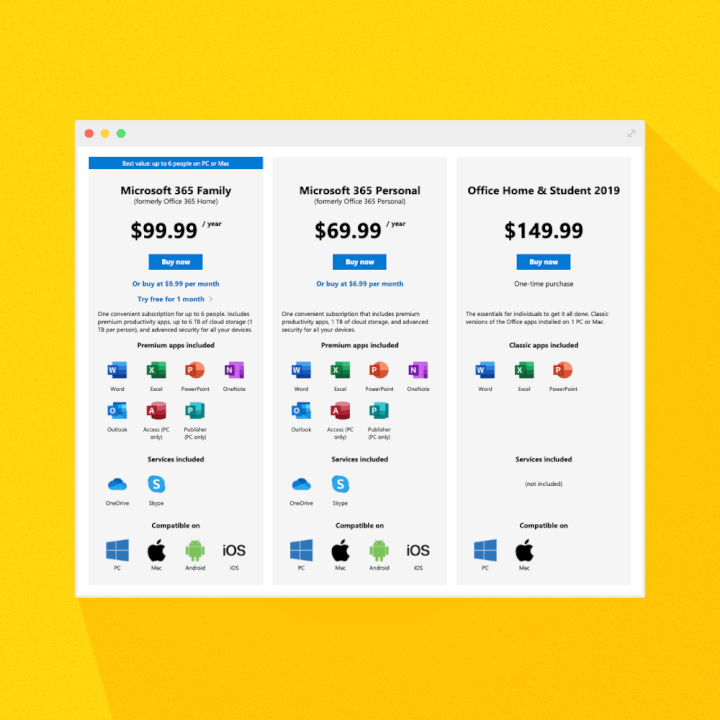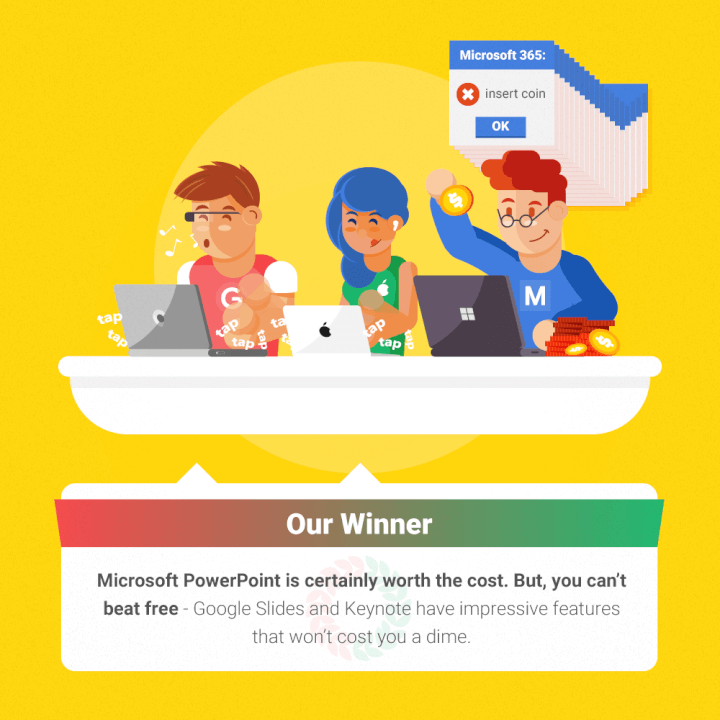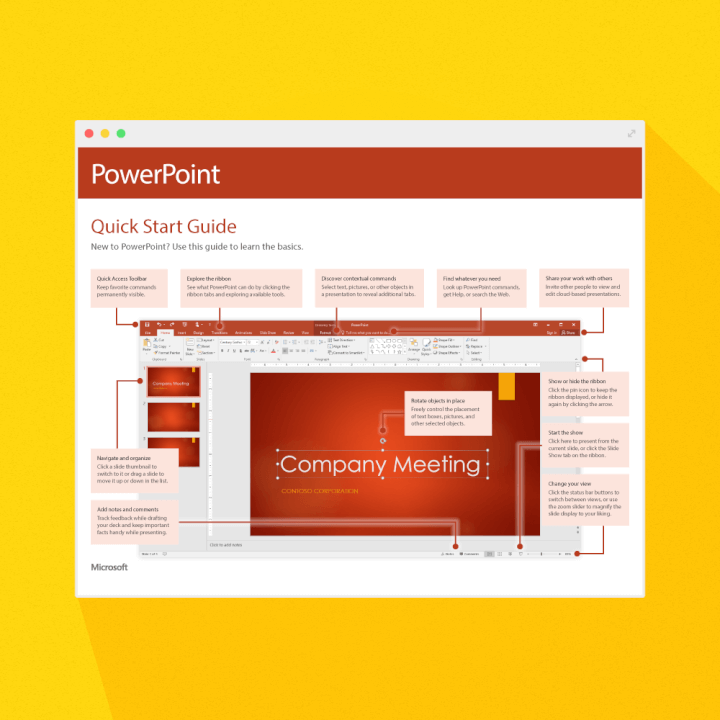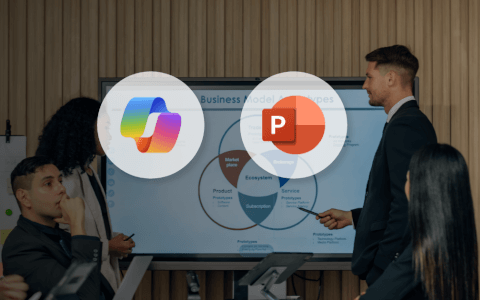Are you trying to figure out which presentation program to go with?
Between Google Slides vs PowerPoint or Apple Keynote, it can be hard deciphering the differences between each one -- especially if you’re short on time.
Fortunately, you don’t have to.
We’ll be doing the hard work for you by comparing the similarities and highlighting the differences between these common presentation platforms.
You’ll have everything you need to narrow down which option is best for your needs. So you can spend more time creating an awesome presentation!
So let’s start by identifying what history and experience each company (Microsoft, Apple, and Google) brings to table in terms of presentation programs.

Google Slides vs PowerPoint vs Keynote background information
If you were going to hire someone new to your company, you’d check out their work history and experience.
So before we get into the specifics of each presentation software, you should know a little bit more about the companies behind these products.
Let’s start with the oldest, and probably the most experienced, of the three.
Step up your PowerPoint game
Download our print-ready shortcut cheatsheet for PowerPoint.
Microsoft
Microsoft has been around since 1975 and has remained one of the top leaders in software and technology.
In 1989, they released one of their first versions of Microsoft Office, a suite of applications designed to improve productivity. This makes it the oldest company in the presentation software space, compared to Apple Keynote and Google Slides.
Since its earliest version, Microsoft PowerPoint has continued to grow and evolve with our ever-changing technology, as you’ll see in this guide.
Not too far behind you’ll find the next player to enter this space: Apple with Keynote.
Apple
Apple’s founders, Steve Jobs and Steve Wozniak, created their company in 1976, just one year after Microsoft.
Their initial focus was on making computers accessible and small enough so everyone could have one in their home or office. This decision changed computers forever.
Yet it wasn’t until 2003 that Apple caught on to the presentation application bandwagon with its Keynote program.
That’s 14 years later than Microsoft debuted PowerPoint -- big difference!
Even still, Apple has more time in the presentation realm than Google Slides has under its belt.
Google’s story starts much later than Microsoft’s and Apple’s.
Back in 1995, Stanford University students Larry Page and Sergey Brin brainstormed the idea Backrub, a place where the world’s information could be organized and easily accessed.
This eventually turned into Google, the search engine powerhouse we know today.
But Google didn’t stop there and has since expanded beyond its original reach.
In creating its own version of Microsoft’s Office Suite, including Google Docs and Google Sheets, Google Slides was born.
Now that you know each company’s brief history, this leads us to our first tally mark.
The Verdict: Microsoft Office
If you were to choose a presentation software based solely on its history and experience, Microsoft Office has both Apple Keynote and Google Slides beat.
For many people, there’s nothing like an original and Microsoft PowerPoint is just that. It’s familiar, reliable, and its updates only add to what you already know.

But how long a product has been around isn’t the only factor to consider.
As you’ll see next, the features, pricing, and accessibility of a presentation program should also weigh in.
When features matter the most
For some users, it’s all about the features.
People in this group want to know that they have the ability to bring their wildest creations to life, even if we’re only talking about presentations here.
Because of this, let’s discuss the features and specs of each presentation program, starting with the old tried-and-true first.
Microsoft PowerPoint features
PowerPoint, along with Keynote and Slides, comes stacked with your basic presentation options, such as the ability to:
-
Add text, images, videos, and hyperlinks to your slides
- Choose from hundreds of font options
- Use basic transitions (8 to choose from) and animations (37)
- Start with or customize one of their pre-built themes
- Include Excel charts
- Automatically proofread
- Print to PDF
Another shared feature between PowerPoint, Google Slides, and Keynote is the capability to make changes in real-time and share those updates with team members from anywhere in the world.
Specific standout features of Powerpoint include:
- PowerPoint Designer, which lets you use impressive cinematic transitions.
- Broadcast Live, which lets you share your slideshow presentation in real-time with anyone who has access to the show. This means you can present to a larger audience and spread your message even further.
- Presenter View, which lets you project your slideshow to a second screen. See your speaker notes as well as the current and upcoming slide in this view. This is especially helpful when you’re presenting your slideshow in person and you don’t want to be stuck fumbling through paper index cards.
But, buyer beware, the PowerPoint Designer is a premium feature that’s only part of Microsoft 365 (the paid subscription service of Microsoft Office) and Broadcast Live is only available in the online version.
Microsoft also lets you create custom animations by combining some of their existing animation options.
You can even embed your PowerPoint presentation on a web page or blog if you want.
Up next, you’ll see how Keynote’s features compare with PowerPoint’s.
Apple Keynote
Apple’s Keynote presentation program comes packed with 30 new and updated pre-designed templates, and getting started is fairly easy too.
But this is also something both PowerPoint and Slides have in common.
They also share the following features:
- Ability to collaborate in real-time, including between PC and PowerPoint users
- Live on-canvas previews to help you see how your animation plays out on each slide
- Showcase presentations that run on their own at kiosks and in-store displays
- Interactive charts and Excel tables
- A simple toolbar to quickly edit and update your slides
So are there any differences here?
The short answer: yes.
First, Keynote also includes 30 cinematic transitions for you to play with and choose from.
While this is an upgrade feature for PowerPoint, it’s free of charge for Keynote users.
Next, you can also use the secure Touch ID passcode on supported Mac products to ensure your slideshow and important data never fall into the wrong hands.
This feature means anyone who receives access to the slides must have the correct user fingerprint before they can proceed with opening or using the slideshow.
And finally, you can control your slideshow directly from your phone, iPad, or Apple watch.
Simply connect to iCloud to pull up your presentation and then use your phone as your slideshow moderator. It’s that easy.
It’s this exact trait our next presentation program also delivers on.
Google Slides
Google Slides is just as easy to use as PowerPoint and Keynote, plus, it also gives you the ability to collaborate from wherever you and your team members are in the world.
You’ll also score the following features with Slides:
- 26 themes to choose from this time
- The ability to embed videos and use animations
- Automatic save feature so every change is recorded without you having to press the save button
- A revision history that shows you when changes were made, plus the ability to restore to older versions
- Compatibility with PowerPoint presentations; you can also save Slide presentations as PowerPoint files
- Ability to convert PowerPoint presentation to Slides and vice versa
Similar to Keynote, Google Slides also allows you to present without having to be connected through wires.
You can do this using Chromecast, Airplay, or Hangouts.
So what’s our top pick when it comes to comparing features?
The Verdict: It depends on your needs
When it comes to features, it really depends on what your team needs and your budget.
As you’ll see later in this guide, PowerPoint will cost you more money while Slides and all its features is totally free. This makes it more enticing, especially for teams.
But if your team is dealing with high-security files regularly, having the ability to put a passcode on your presentations can be important, which means Keynote is your best option here.
And if animations are a top priority for you, you’ll need to consider if you’re willing to spend the extra bucks it takes to upgrade and enjoy PowerPoint’s Designer feature.
Otherwise, Keynote and Slides win out here.

Before you make your final decision, there are a few more categories to think about.
Templates and designs
As we mentioned earlier, each presentation program has its own selection of templates to choose from.
If you know you don’t have the time to design your own slides, you should always check your options for pre-designed layouts first.
So let’s take a peek at PowerPoint’s template choices.
PowerPoint templates
PowerPoint comes stocked with 19 pre-made templates.
Here’s what their options look like:

You can see the first few rows have designs with illustrations while the middle ones are more professional and geometric in style.
The last six templates are less about the design and even more customizable.
Let’s see how Apple’s templates compare now.
Keynote templates
Apple’s theme chooser shows you a thumbnail of the 30 templates you can select from:

You can see there’s a mix of big, bold imagery, plain text slides, and ones with larger text to help your presentations really stand out -- something Apple does well.
The templates in Google Slides also contain a similar mix of themes.
Google Slides themes
Here’s how Google’s pre-designed layouts compare:

Once again, there’s a mix of slideshows with bold imagery paired with text-heavy choices to give you plenty of options.
So which presentation software is the winner here?
The Verdict: Google Slides or Apple Keynote
Unfortunately, while Microsoft has a decent amount of templates to choose from, some of the themes are ultra-specific (I’m looking at you Classroom Timer deck).
This means you may not even use half the templates you’re given.
Slides and Keynote differ here. Their versatility and modern designs are much more usable and streamlined for both casual and professional users.
As for a clear winner, we think it’s a tie here.
While Apple’s eye-catching templates are awesome, if you don’t find them appropriate for your presentations, you may only use a handful of simpler designs.
Google Slides themes may have the upper hand here since they’re already pretty universal.

On top of features, the price is usually another area worth comparing and this head-to-head battle is no different.
Google Slides vs PowerPoint vs Keynote : How do their prices compare?
Let’s keep this section simple: Microsoft PowerPoint is the only option out of the three you have to pay for, with one exception.
If you’re a student or teacher, you can enroll in Microsoft 365 for free by using your school email address.
But once you graduate or end your teaching career, you’ll be stuck paying for it like the rest of us.
There’s also one more difference with Microsoft worth noting: when the Office Suite first came out, you’d simply purchase the set via compact disks you installed on your computer (or it came with the suite pre-installed, depending on the computer model you purchased).
This meant you paid one fee to have the rights to use the program for as long as you kept your discs scratch-free.
Now, Microsoft 365, which is the latest version of the Office Suite, is only sold on a subscription-based model.

So you either pay $99.99 per year for the family home package (5 users), or $69.99 per year for the personal use plan (one user per year).
Keep in mind, a user is not counted as just another person using the program.
If one person in your house has both a desktop and a laptop that needs the Suite, you’ll be losing two users out of your five total in the package, not one.
Not only that, your annual fee is no longer a one-and-done deal either -- you must keep paying for it each year to keep your Suite active.
On the other hand, Keynote and Google Slides are both free.
That means you won’t pay anything to use or download these presentation programs.
And that’s why the winner is clear here.
The Verdict: Go with Slides or Keynote if you’re looking for low-cost
Both Keynote and Google Slides give you plenty of features to create attention-grabbing presentations for zero dollars.
So if price and your budget are concerns for you, you’re better off using one of these programs instead of Microsoft PowerPoint.
The decision should be a little easier if you are a PC user too since Keynote is an Apple product and only available for Mac users.

Now that you have a better idea of how each program compares, we’ll show you how to get started with each one.
How to access Microsoft PowerPoint, Apple Keynote, and Google Slides
Follow these steps to start using PowerPoint, Keynote or Google Slides today.
Getting started with Microsoft PowerPoint
To access PowerPoint, you’ll need to purchase a Microsoft 365 subscription.
You can do that by visiting this page.
Once your subscription is activated, you just need to sign into your account using this URL: www.office.com/signin and download the programs to your computer.
From there, you can start using PowerPoint.
It’s also a good idea to check out their PowerPoint tutorial so you can get yourself familiar with the platform faster.
Here’s what that looks like:

And since Keynote and Slides are free to use, getting set up with those two programs is even easier than it is with PowerPoint.
Getting started with Apple Keynote (Mac users only)
To download Keynote, you just need to head to the App Store in iTunes.
Once you type in Keynote in the search box, you’ll see this screen:

Click the ‘Get’ button (where the red arrows are pointing in the image) to start the download process.
Once Keynote has been installed, you can move around in a similar way as you would with PowerPoint:

Your slide overview is to the left while your dashboard for editing and making changes is on top:

Google Slides has a similar dashboard to this one.
Getting started with Google Slides
As long as you have a Google account, you can easily get started with Google Slides just by visiting: https://docs.google.com/presentation/u/0/. To sign up for Google, check out this page.
Once you’re there, you’ll have the option to create a new presentation or open an existing one:

And when you click on the plus sign to create a new presentation in Slides, you’ll see this screen next:

Here, you have the ability to view all your slides at once, choose a theme, or edit your slides for a custom design.
So now that you have all this information in hand, the only step left is to decide which presentation program is right for you.
Google Slides vs PowerPoint vs Keynote comparison table
| PowerPoint | Google Slides | Keynote | |
|---|---|---|---|
| Stand out features | Most fully featured program, regular updates |
Collaboration, automatically saves to cloud |
Stylish, designed specifically for Macs |
|
Built-in templates |
Ultra-specific |
Universal |
Eye-catching |
|
File format |
.pptx |
.gslides |
.key |
|
Accessibility |
Offline and online |
Offline and online |
Offline and online |
|
Platform |
PC and Mac |
PC and Mac |
Mac |
|
Price |
$69.99/year (1 user) $99.99/year (5 users) Free for students and teachers |
Free |
Free |
Google Slides vs PowerPoint vs Keynote: Which one will you choose?
If the price is of no concern, Microsoft PowerPoint is your best option since it comes stacked with original features and consistent updates.
But, if the annual fee tagging alongside Microsoft 365 is a little too high to justify, Google Slides and Keynote are not only affordable but also comparable in specs too.
We think you should give each program a test run for a week to see which features you value most and decide what’s right for you.
If you need help learning how to use all these awesome programs, check out our PowerPoint, Keynote, and Google Drive & Apps courses to pick up some insider tips and tricks!
If you enjoyed today’s guide, check out this one on Microsoft Word vs Google Docs next.
Ready to master Microsoft Office?
Start learning for free with GoSkills courses
Start free trial




